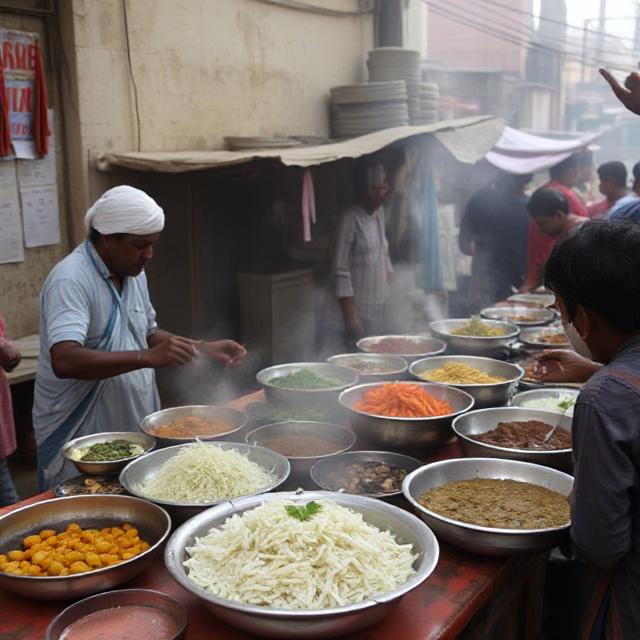Six Indian Cities Dominate TasteAtlas’s 100 Best Food Cities: A Culinary Journey Through India’s Gastronomic Excellence
India’s Culinary Renaissance: Six Cities Make Global Mark
India shone on the global stage with six cities making it to TasteAtlas’s prestigious 100 Best Food Cities list, with Mumbai claiming an impressive 5th position worldwide. This remarkable achievement underscores India’s growing influence in the global culinary landscape and highlights the rich gastronomic heritage that has captivated food enthusiasts worldwide.
The TasteAtlas Awards 2024-25 have become the definitive guide for food lovers seeking authentic culinary experiences, and India’s strong representation signals the country’s emergence as a premier food destination. Indian cuisine was placed at the 12th position in TasteAtlas’s rankings for the world’s best cuisines, providing context for the individual city achievements.
Mumbai: The Crown Jewel at 5th Position
Mumbai has emerged as the 5th best food city in the world according to TasteAtlas Awards 2024-25, recognized for its dynamic food scene and culinary richness. The financial capital of India has transformed into a gastronomic powerhouse, where traditional street food meets contemporary culinary innovation.
Mumbai’s Signature Dishes and Food Culture
Mumbai’s food identity is intrinsically linked to its vibrant street food culture. The city’s bustling streets serve as open-air restaurants where millions of residents and visitors experience authentic flavors daily. According to TasteAtlas rankings, Mumbai is famous for Bhelpuri, Pav Bhaji, Vada Pav, Modak, and Panipuri.
Vada Pav: Mumbai’s Beloved Street Food Often called Mumbai’s burger, Vada Pav represents the city’s innovative approach to affordable, filling street food. This humble combination of a deep-fried potato dumpling served in a bread roll has become synonymous with Mumbai’s food identity.
Pav Bhaji: The Social Equalizer Pav Bhaji transcends social boundaries in Mumbai, bringing together people from all walks of life. This spiced vegetable curry served with buttered bread rolls originated in the city’s textile mills and has evolved into a globally recognized dish.
Bhelpuri and Mumbai’s Chaat Culture The crispy, tangy flavors of Bhelpuri represent Mumbai’s mastery of chaat culture. This mixture of puffed rice, vegetables, and chutneys creates a symphony of textures and flavors that captures the essence of Mumbai’s fast-paced lifestyle.
Mumbai’s Culinary Evolution
Mumbai’s rise to the 5th position reflects the city’s ability to preserve traditional recipes while embracing culinary innovation. The city hosts numerous food festivals, pop-up restaurants, and culinary experiments that have elevated its global profile. From the historic Irani cafes to modern fusion restaurants, Mumbai offers a complete culinary ecosystem.
Amritsar: Punjab’s Culinary Capital at 43rd Position
Amritsar showcases dishes like Amritsari kulcha (4.7), Palak paneer (4.2), Dal makhani (4.1), Sarson da saag (3.5), and Pinni (5), representing the rich Punjabi culinary tradition. The city’s 43rd position reflects its authentic approach to traditional Punjabi cuisine.
The Dhaba Culture of Amritsar
Amritsar’s food scene is dominated by traditional dhabas that have preserved authentic Punjabi recipes for generations. Establishments like Kesar da Dhaba, Bharawan Da Dhaba, Bade Bhai ka Brothers Dhaba, Crystal Restaurant, and Pehelwan Kulcha continue to serve traditional recipes that have remained unchanged for decades.
Amritsari Kulcha: A Culinary Masterpiece The Amritsari kulcha stands as the city’s most famous contribution to Indian cuisine. This stuffed bread, cooked in traditional tandoors and served with chole (chickpea curry), represents the hearty, satisfying nature of Punjabi food.
Dal Makhani: The King of Lentils Amritsar’s dal makhani represents the pinnacle of lentil preparation. Slow-cooked black lentils with butter and cream create a rich, velvety texture that has made this dish a global favorite.
Religious and Cultural Significance
Amritsar’s food culture is deeply intertwined with its religious significance as home to the Golden Temple. The community kitchen (langar) at the Golden Temple serves thousands of free meals daily, embodying the Sikh principles of service and equality while showcasing traditional Punjabi cooking techniques.
New Delhi: The Capital’s Culinary Diversity at 45th Position
New Delhi’s 45th position reflects the city’s role as a melting pot of Indian cuisines. As the national capital, Delhi has become a repository of regional Indian dishes, creating a unique culinary landscape that represents the entire country’s food heritage.
Delhi’s Street Food Legacy
Delhi’s street food scene is legendary, with areas like Chandni Chowk, Karim’s, and Paranthe Wali Gali serving as pilgrimage sites for food enthusiasts. The city’s street food combines influences from various regions, creating distinctive Delhi-style preparations.
Chole Bhature: Delhi’s Breakfast Champion This combination of spiced chickpeas with deep-fried bread represents Delhi’s love for substantial, flavorful breakfasts. The dish has become synonymous with weekend indulgence in the capital.
Delhi-Style Chaat Delhi has developed its own interpretation of chaat, incorporating local preferences and ingredients. Dishes like aloo tikki chaat and golgappa showcase the city’s innovative approach to traditional recipes.
Regional Cuisine Hub
Delhi’s strength lies in its ability to serve authentic regional cuisines from across India. From South Indian restaurants in Karol Bagh to Bengali sweet shops in CR Park, Delhi offers an authentic taste of India’s diverse culinary landscape.
Hyderabad: The Biryani Capital at 50th Position
Hyderabad’s 50th position celebrates the city’s status as India’s biryani capital. TasteAtlas has highlighted Hyderabadi biryani among standout dishes, recognizing the city’s contribution to one of India’s most beloved dishes.
The Art of Hyderabadi Biryani
Hyderabadi biryani represents the pinnacle of rice preparation in Indian cuisine. The city’s biryani culture reflects the sophisticated cooking techniques developed during the Nizami period, combining Persian influences with local ingredients.
Dum Cooking Technique Hyderabad’s signature cooking method involves slow-cooking rice and meat in sealed pots, allowing flavors to develop gradually. This technique, known as dum, creates the distinctive taste and aroma that defines Hyderabadi biryani.
Traditional Accompaniments Hyderabadi biryani is traditionally served with raita, shorba, and boiled eggs, creating a complete meal experience. The city’s biryani restaurants have preserved these traditional serving methods for generations.
Beyond Biryani: Hyderabad’s Diverse Food Scene
While biryani dominates Hyderabad’s food identity, the city offers diverse culinary experiences. Traditional Hyderabadi sweets like double ka meetha and qubani ka meetha showcase the city’s dessert culture, while dishes like haleem represent the city’s ability to create comfort food from simple ingredients.
Kolkata: The City of Joy’s Food Culture at 71st Position
Kolkata’s 71st position reflects the city’s unique food culture that blends Bengali traditions with global influences. The city’s intellectual and cultural heritage is reflected in its approach to food, where meals are considered social and cultural events rather than mere sustenance.
Bengali Cuisine Excellence
Kolkata represents the heart of Bengali cuisine, known for its subtle flavors and emphasis on fish and rice. The city’s food culture emphasizes seasonal ingredients and traditional cooking techniques passed down through generations.
Fish Culture Kolkata’s relationship with fish goes beyond cuisine to cultural identity. Dishes like ilish bhapa and chingri malai curry represent the city’s mastery of seafood preparation, showcasing techniques that maximize the natural flavors of fresh fish.
Sweet Traditions Kolkata’s sweet culture is legendary, with traditional sweets like rasgulla, sandesh, and mishti doi representing the city’s contribution to Indian dessert culture. These sweets require precise techniques and have become symbols of Bengali hospitality.
Street Food and Adda Culture
Kolkata’s street food scene supports the city’s famous adda (informal conversation) culture. Food stalls and tea shops serve as social gathering places where literature, politics, and culture are discussed over shared meals.
Chennai: South India’s Culinary Ambassador at 75th Position
Chennai’s 75th position represents South India’s distinct culinary tradition on the global stage. The city serves as the gateway to South Indian cuisine, showcasing the region’s emphasis on rice, lentils, and coconut-based preparations.
Traditional South Indian Breakfast Culture
Chennai’s breakfast culture centers around fermented foods that showcase South India’s understanding of nutrition and flavor development. Dishes like idli, dosa, and upma represent the region’s mastery of grain-based preparations.
Filter Coffee Culture Chennai’s filter coffee culture represents more than just a beverage; it’s a social ritual that brings people together. The city’s coffee preparation techniques and serving traditions have influenced coffee culture across India.
Temple Food Traditions Chennai’s proximity to numerous temples has influenced its vegetarian food culture. Temple prasadam and traditional vegetarian restaurants showcase the city’s spiritual connection to food preparation.
Modern Culinary Evolution
Chennai has embraced culinary innovation while preserving traditional recipes. The city’s restaurant scene includes everything from traditional banana leaf meals to contemporary fusion cuisine, reflecting South India’s evolving food culture.
TasteAtlas Methodology and Global Recognition
TasteAtlas food rankings are based on the ratings of the TasteAtlas audience, with mechanisms that recognize real users and ignore bot, nationalist or local patriotic ratings, giving additional value to ratings from users recognized as knowledgeable. This methodology ensures that the rankings reflect genuine culinary experiences rather than biased voting.
The Significance of Global Food Rankings
Global food rankings like TasteAtlas serve multiple purposes beyond tourism promotion. They:
- Preserve traditional recipes and cooking techniques
- Encourage culinary tourism and cultural exchange
- Support local food businesses and traditional restaurants
- Document disappearing food cultures
- Create international awareness of regional cuisines
Impact on Indian Tourism and Economy
The recognition of six Indian cities in TasteAtlas’s top 100 list has significant implications for India’s tourism industry and economy. Food tourism has become a major driver of international travel, and this recognition positions India as a premier culinary destination.
Culinary Tourism Growth
The global recognition of Indian food cities is expected to boost culinary tourism, bringing international visitors specifically for food experiences. This trend benefits not only restaurants but also local farmers, spice merchants, and traditional food artisans.
Preservation of Food Heritage
International recognition encourages the preservation of traditional cooking techniques and recipes. Young chefs and food entrepreneurs are increasingly interested in documenting and modernizing traditional recipes while maintaining their authentic character.
The Future of Indian Culinary Excellence
India’s strong showing in international food rankings reflects a broader trend of global appreciation for authentic, traditional cuisines. The success of these six cities provides a roadmap for other Indian cities to develop their food tourism potential.
Emerging Food Cities
Several Indian cities are developing food scenes that could achieve international recognition in future rankings:
- Jaipur: Known for traditional Rajasthani cuisine and royal cooking techniques
- Lucknow: Famous for Awadhi cuisine and kebab culture
- Kochi: Representing Kerala’s spice-rich coastal cuisine
- Mysore: Showcasing South Indian vegetarian traditions
- Goa: Blending Indian and Portuguese culinary influences
Challenges and Opportunities
While international recognition brings opportunities, it also presents challenges:
Maintaining Authenticity: Balancing commercial success with traditional recipe preservation Infrastructure Development: Improving food safety and hygiene standards for international visitors Cultural Sensitivity: Educating visitors about food customs and dining etiquette Sustainable Tourism: Managing increased visitor numbers without overwhelming local communities
Conclusion: India’s Culinary Renaissance
The inclusion of six Indian cities in TasteAtlas’s 100 Best Food Cities represents more than just recognition; it marks India’s emergence as a global culinary superpower. From Mumbai’s innovative street food culture to Chennai’s traditional South Indian preparations, these cities showcase the incredible diversity and sophistication of Indian cuisine.
This achievement reflects years of culinary evolution, where traditional recipes have been preserved while embracing innovation and international influences. The success of Mumbai, Amritsar, New Delhi, Hyderabad, Kolkata, and Chennai provides inspiration for other Indian cities to develop their unique food identities and compete on the global stage.
As India continues to gain international recognition for its culinary excellence, these six cities serve as ambassadors for the country’s rich food heritage. Their success in the TasteAtlas rankings not only celebrates past achievements but also points toward a future where Indian cuisine continues to gain global appreciation and respect.
The journey from local street food stalls to international recognition demonstrates the power of authentic cuisine to transcend cultural boundaries and create universal appreciation. India’s food cities have proven that traditional recipes, when prepared with passion and served with pride, can compete with any cuisine in the world.











